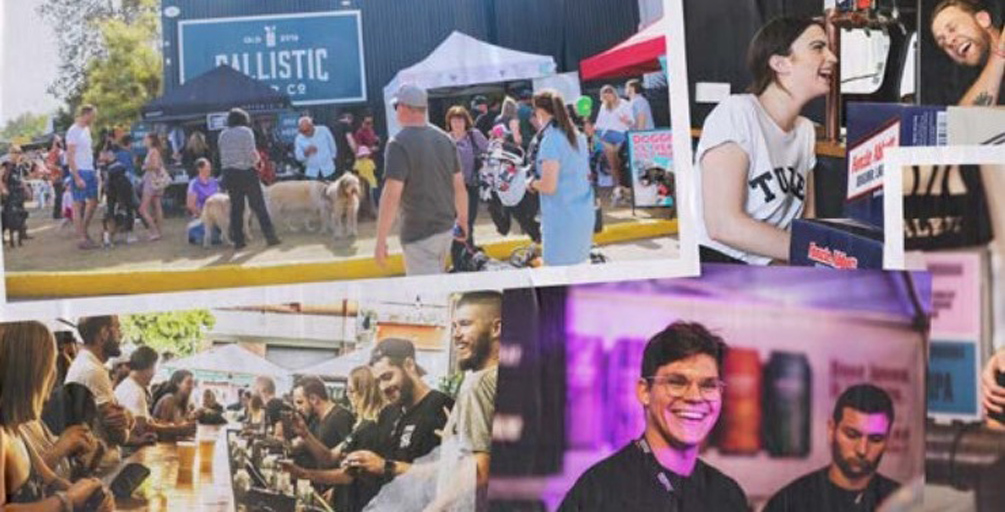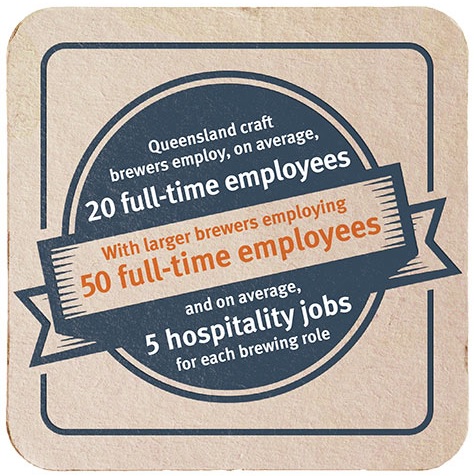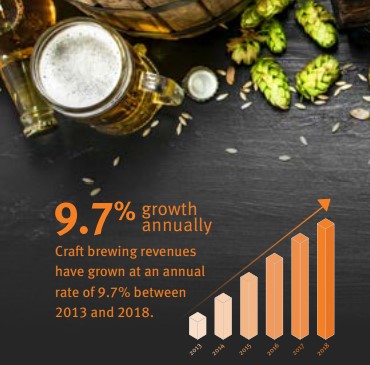
One Year On… Queensland Craft Beer Strategy

Images from the Queensland Craft Beer Strategy
The Queensland government’s Craft Beer Strategy was launched a year ago this month, promising big things for the region’s brewing industry.
“It’s been a year since we said we were ‘tapping into Queensland’s potential’ with the release of the Queensland Craft Brewing Strategy. It was more than just creative wordplay. It was a promise,” Cameron Dick, Queensland’s Minister for the Department of State Development told Brews News in the lead up to the anniversary.
Twelve months on there have been mixed reactions in the industry to the state government’s delivery of the strategy.
Jack Milbank of Bargara Brewing in Bundaberg, who participated in the working group to develop the strategy, said the advisory panel had not met in the past year. He was dismayed at the actions undertaken so far, saying they were largely piggybacking off existing infrastructure, as well as the ongoing and pre-existing work of other departments and private sector interests.
“I’m on the craft beer advisory panel and not a lot has happened I believe. The last meeting we had was a year ago. I’ve learnt to not expect too much and then I won’t be disappointed,” Milbank said.
“All that’s happening is that the government is doing market research, funded by them, into opportunities for itself to generate revenue off an industry.”
Craig Parsell, chairman and co-founder of Hemingway’s Brewery said there was “not much to speak about at this stage as little progress has been made”.
He was also part of the working group, and said that since there had been no physical meetings but a “few” follow up calls, most recently on producer licence options.
David Kitchen, IBA Queensland representative and founder of Brisbane’s Ballistic Beer however said the industry had high hopes for the strategy.
“Generally we [the IBA] were happy with what they said they were going to do. All the timelines were feasible. There was a high expectation that things would be achieved as a result,” he told Brews News.
“At the end of the day, State Development does come in and has batted for us on a number of things.
“They are trying to work with us so things like the fire services fee doesn’t happen again, but if another department bungs something through and doesn’t talk to State Development we can’t really blame them for it.
“Certainly Cameron Dick and the State Development department do have our best interests at heart,” he said.
Export and tourism
Export, tourism and supply chain issues were highlighted as key areas of improvement in the strategy when it was announced last November.
The state government said at the time it wanted to “develop closer links between growers and brewers” through the Department of Agriculture and Fisheries, as well as using the government’s trade networks to build relationships in overseas markets, support brewers to access export ready programmes and connect export-ready brewers to international trade shows.
“I wouldn’t say a lot’s happened with export but I don’t think there are many people that are really ready for it, and it’s something we could still do more on,” Kitchen said.
Kitchen’s brewery Ballistic, Newstead Brewing Co and Slipstream Brewing recently took up the opportunity for a free state stand at an event in Hong Kong, the HOFEX, as part of Trade and Investment Queensland’s Taste of Queensland display.
“We should still be continuing to encourage the state government that when they do trade missions, we’re included as part of that,” Kitchen said.
Bundaberg’s Bargara Brewing also reportedly attended an event in Singapore, for which they paid $8,000 according to Milbank.
“Absolutely you’ve got to be in it to win it, but it’s at significant expense to the exhibitors,” Milbank said.
“Trade Investment Queensland exhibited a stand funded by all the participants, which happens irrespective of any Craft Beer Strategy or not.
“TIQ staff have been fantastic, but they existed completely separate to any strategy.”
In terms of promoting Queensland-brewed beer within the state, the Department for State Development said that 12 brewers are now listed on the Queensland Government Food and Beverages Supplier Directory, out of an estimated 90 in the region.
It said it was supporting the IBA in encouraging brewers to register their interest for the directory, which is free to list in.
In addition, Minister Dick highlighted that Parliament House also now has six craft beers on its events menu, including Hemingway’s Pilsner, Green Beacon Half Mast, Great Barrier Ale, Ballistic Pale Ale, Newstead IPA and Newstead Session Ale.
Bargara Brewing’s beers were also featured recently at a dinner for Singapore business leaders by the Minister for Agricultural Industry Development and Fisheries Mark Furner.
The Department for State Development also said that over the past year it had been encouraging Queensland brewers to list themselves on Australia’s national tourism database, the Australian Tourism Data Warehouse.
From four breweries prior to the 2018 strategy there were now 24 breweries signed up, the department said. Listing on the site is free in every state except Victoria and Queensland, where companies are charged $200 annually.
Supply chain
When it comes to the logistics networks, the state government said one of its priority actions was to “enhance supply chains”.
Minister Dick said that the department had surveyed Queensland craft brewers and found that just under half the hops they use are sourced from Australia.
“We also found that over half of the barley (malt) is sourced domestically, from Border Malt in Queensland as well as New South Wales, Tasmania and South Australia,” he said.
“This means plenty of opportunities for Queensland agricultural growers to cash in on the craft brewing boom.”
Milbank of Bargara Brewing said that when he had queried completed actions on the development of the brewing supply chain he was told that “discussions with industry confirm there is little scope to enhance supply chain. No further action is required”.
“I’ve been to Goondiwindi and Emerald, every one of these regional towns that produces grain is calling out for support, assistance, funding, to establish small scale regional malt houses so they can grow specialty grains and supply the craft beer brewing industry,” Milbank said.
“No one from any government department has spoken to anybody in those production regions other than saying there’s no room for enhancement of supply chain efficiencies.
“All the brewers are still buying their grain off New Zealand and others – all that’s here is the base pale malt, that’s what everyone is buying. “
Cryer Malt launched Border Malt last year. The grain is malted but not necessarily grown in Queensland, and its introduction was unrelated to the state government’s strategy, launching prior to the Queensland Craft Beer Strategy’s publication.
Brewlab
One of three “key priorities” identified by the Craft Beer Strategy was “investing in people and infrastructure” and this included an investigation into the establishment of a brewlab facility in Queensland by 2020, “subject to a successful business case”.
Last November, the state government said this brewlab would deliver “up to date practical and theoretical brewing skills” with an experienced brewer leading the facility.
Now, one year on, Minister Dick said that the ‘first of its kind’ brewlab will be operating by the end of the year. He did not say where it was or how much they had invested, in a wide-ranging response to Brews News, but the brewers interviewed said they believed it was located on the site of an existing laboratory complex at Coopers Plains, in Acacia Ridge.
Minister Dick said that the “dedicated pilot plant” would enable brewers to develop and test new recipes without interrupting production in their own breweries.
The department said that brewers can access a Sensory Lab for expert and focus group tasting and ‘quality assurance services’ and that brewers will have access to the Grains Quality Research Lab in Toowoomba, which it says offers 24 quality methods across ‘key parameters’.
“We have a very fine laboratory facility already, so the opening of the brewlab is coming up very quickly,” David Kitchen said.
“There is a facility at Acacia Ridge which is a very large lab, and there is a person moving in that lab area to do that. They’re in the process of purchasing brewing equipment, all the scientific equipment possibly needed, so it’s on the way that one.
“It’s also doubling up on resources the government already has. The facility does a lot of testing and food development anyway.”
Milbank was not as convinced.
“I mean there’s already labs there, it’s an existing government facility…[it’s] a service that they’re selling to the brewery industry,” he said.
“That doesn’t require any money being spent, [they are] just adding another suite of products to a new industry through which the government can generate revenue off it.
“This is what they’ve done with every item in the Craft Beer Strategy.”
Training
As part of its commitment to upskilling brewers, the craft beer strategy promised that the government would work with TAFE Queensland to develop a course for craft brewers in 2019.
In its latest update, the department said that in 2020 it would be introducing a Certificate III Program in Food Processing (Brewing) – a similar course of which is available in SA through TAFE – with the announced brewlab becoming a “functional training site”.
However when a TAFE Queensland representative was contacted this week by Brews News, they said there was no information available for the course “so we are not currently delivering this or have anything scheduled”.
“We have information available for all courses up until July – if it is being introduced next year it definitely is not going to be offered in the next 6 months,” they said. Brews News contacted the State Development department to clarify this, with no response received at the time of publication.
David Kitchen said that there was potentially some reluctance on behalf of TAFE to invest in higher certificates specifically in brewing.
“There is some concern by TAFE that there is actually a demand for it. They have to have a business case for it as well,” he said.
Licensing
One area in which there seemed to be some movement, particularly in the past month, was the question of licensing.
The current regimes favour wine producers over brewers not only in relation to satellite and event licence extensions, but even when it comes down to the Queensland container deposit scheme, for which brewers are liable but wine producers are not.
Craig Parsell of Hemingway’s said that movement on licensing was a tentative positive move for the strategy.
“The one potential step forward is the establishment of a producers licence for craft brewers with under 5 million litres annual production,” he said.
“That said, there are some concerns as to how effective this will be on a number of issues, including the fact that the issue around zone-use and council approval will be unlikely to be addressed.”
Proposals for a new licensing regime for brewers are being thrashed out, but early suggestions are restrictive, more so than the licensing options available to the wine industry.
Proposals for the licences so far would only allow 60 patrons seated or 100 standing, which is the same as those placed on a small CBD bar, and would not allow takeaways of any alcohol not made by the brewery. This would mean that even though a potential new licence would allow breweries to sell alcohol made elsewhere without a full commercial hotel licence, it would not be allowed for off-premises consumption.
When asked about the disparity between wine and beer when it comes to regulatory regimes, the Department for State Innovation said that Action 7 of the Craft Beer Strategy “provides a commitment to streamlining the liquor licencing application process to more directly provide the conditions desired by craft brewers”.
“The Department of State Development, Manufacturing, Infrastructure and Planning is currently working with the Commissioner for Liquor and Gaming, in close consultation with industry to streamline licencing requirements for craft beer producers,” a spokesperson said.
A reworking of licences for breweries could head to cabinet as early as the end of November.
Fire management levy and BrewDog
BrewDog’s venue DogTap Brisbane is set to launch this month – one year late and under the capacity promised in its initial plans, despite receiving financial incentives from the Queensland Government.
The state government and local authorities have thrown their weight behind the Scottish brewery, which was the catalyst for the introduction of the Craft Beer Strategy in the first place.
Brisbane City Council has invested $1.5 million in improving a jetty and therefore access to the BrewDog site at the Murarrie Recreation Hub, although according to the council it is “not linked” to the BrewDog development, but is part of a separate $18 million investment in riverside transport and recreation.
This contrasts with state government relations with domestic brewers. One of the most high profile failures the Craft Beer Strategy in the past year, the fire management levy debacle highlighted a lack of communication between government departments.
Queensland’s breweries were hit with a 900 per cent rise in emergency management levies, as the licence fee was pegged to taverns, leading to uproar in the industry. Some breweries even said that if the levy hike was enforced, they would be forced to shut down – directly contravening the aims of the strategy.
It highlighted a lack of communication around the strategy at state government level.
“I suppose it’s a two-way thing with the department in the case of the fire levies, that department didn’t speak to the state development department,” according to David Kitchen of the IBA.
“Once we kicked up a stink there was close discussion between State Development and the fire services. Things are still to be properly resolved in the fire services area.”
When asked to clarify a number of details about the revamped emergency management levy categories, the departments were again unable to agree.
Queensland Fire and Emergency Services, which were behind the hike initially, said that it could not guarantee that a brewer would be paying the same amount as was charged in 2018/19.
“The category a brewer or distiller is charged under in the 2019/20 financial year, and any financial adjustments that result, will be determined by the local council,” a spokesperson said.
When asked the same questions at the same time in September, the Department for State Development said that “rates notices will be adjusted to ensure the annual payment for brewers and distillers will remain the same as it was in 2018-19”.
Minister Dick addressed the emergency management levy issue in his most recent response to Brews News.
“Revising the Emergency Management Levy arrangements is a clear show of support for smaller brewers and distillers,” he said.
“The changes ensure they’re paying a levy based on building size rather than a flat fee across the board. Craft brewers told us what they needed, and we listened.
“This potential is why we’re invested in craft brewing. And with the right investment, craft brewing can make a big impact on the Queensland economy. Because when our local manufacturers thrive, the whole state thrives.”





